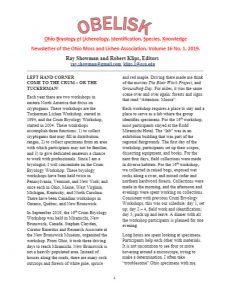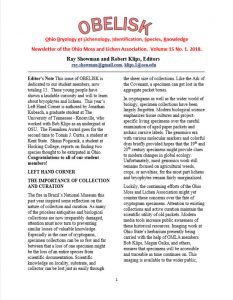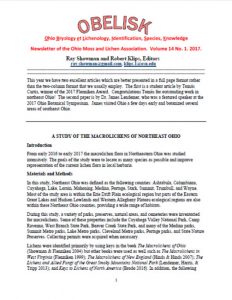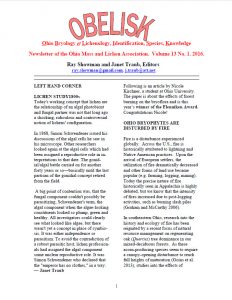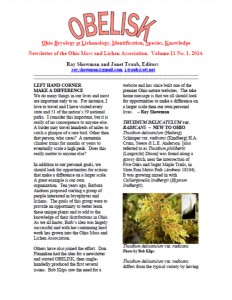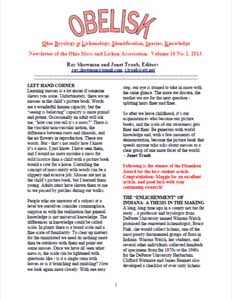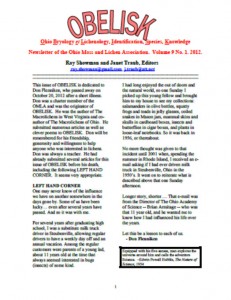The Ohio Moss and Lichen Association (OMLA)
newsletter is called OBELISK.
View/download the latest issue here.
Guidelines for Authors (link)
See below for earlier issues.
See any errors in the new issue?
Send the webmaster a note and we can make corrections.
EARLIER ISSUES
ANNOUNCING THE FLENNIKEN AWARD
In remembrance of Don Flenniken, an award of $100 has been established for the best article submitted to OBELISK each year by a student member of the Ohio Moss and Lichen Association. Articles should be about some aspect of bryology or lichenology with a text of at least one single-spaced page. Accompanying photographs are encouraged, and priority will be given to original research. Articles may be in the informal style (see recent issues of OBELISK) or in the more formal style of a journal paper. Articles should be submitted by November 1 to allow judging before the OBELISK deadline. Good luck students!
INDEX AND LINKS TO VOLUMES 1-8 OF OBELISK
(Newsletter of the Ohio Moss and Lichen Association (OMLA)
The Ohio Moss and Lichen Association (OMLA) newsletter is called the OBELISK, which stands for Ohio Bryology et Lichenology, Identification, Species, Knowledge. In addition, the obelisk, found in most cemeteries, provides a nice microhabitat for several species of lichens and mosses. William Starling Sullivant (1803-1873), considered by many to have been the Father of American Bryology, lies beneath the shadow of an obelisk in Greenlawn Cemetery in Columbus, Ohio.
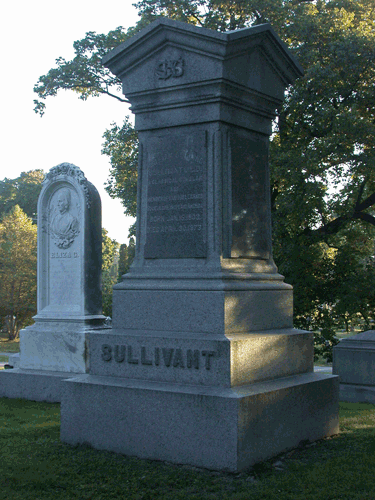 The inscription reads:”William Starling Sullivant L.L.D.
The inscription reads:”William Starling Sullivant L.L.D.
A Classical Scholar and Member of Various Learned Societies in Europe and America.“
OBELISK volume 1 (2005) (.pdf link)
OBELISK. Don Flenniken. 2005. P. 1.
The name of the newsletter for the Ohio Moss and Lichen Association is the OBELISK (an acronym for Ohio Bryophytes et Lichens: Information, Science, Knowledge). William Starling Sullivant, considered to be the Father of American bryology, lies beneath the shallow of an obelisk.The inscription reads “William Starling Sullivant L.L.D. A Classical Scholar and Member of Various Learned Societies in Europe and America.”
ORGANIZATION. Don Flenniken. 2005. P. 1.
The Ohio Moss and Lichen Association had its initial organizational meeting on June 3, 2004 at the Gorman Nature Center, Lexington, Ohio.
October 22-24. Adams County [Ohio]. Don Flenniken. 2005. P. 2.
The fall foray of the Ohio Moss and Lichen Association took place at the Edge of Appalachia Preserve System. The complete collection from this foray will be published in Evansia. Lucas County [Ohio] April 16, 2005.
Don Flenniken. 2005. P. 2.
Jim Toppin and Janet Traub hosted the April 16, 2005 spring foray to Lucas County.
Bryophytes and Lichens from Lucas County, Ohio. Barb Andreas and Ray Showman. 2005. P. 2-5.
Lists of bryophytes and lichens collected on the Ohio Moss and Lichen spring foray are presented. The lists include 19 species of lichens and 36 species of bryophytes from the Lou Campbell State Nature Preserve, and 17 species of lichens and 13 species of bryophytes from the Roche de Boeuf Park, Farnsworth Metro Park.
Photo, Organizational Meeting, June, 2004. Diane Lucas. 2005. P. 6.
Photo, Participants in Fall Foray to Adams County, October 2004. Bob Klips. 2005. P. 6.
OBELISK volume 2 (2006) (.pdf link)
Photo, Participants in Fall Foray to Lawrence and Jackson Counties, 2005. Bob Klips. 2006. P. 1.
Lefthand Corner. Don Flenniken. 2006. P. 2.
Changes in identification techniques are causing nomenclatural changes which make it hard to keep up with all the name changes.
OMLA Midwinter Meeting. Bob Klips. 2006. P. 2.
The OMLA winter meeting will be held on January 21, 2006 at the Ohio State University Marion Campus. The meeting will focus on identification techniques and identifying difficult specimens.
Ohio Moss and Lichen Association – 2005 Fall Foray Sites. Ray Showman. 2006. P. 3-4.
Lists of macrolichens collected on the OMLA fall foray to Lawrence and Jackson Counties are presented. The lists include 46 macrolichens from the Wayne National Forest, 17 of which are county records. Forty-four species of macrolichens were collected at Canter’s Cave 4-H Camp in Jackson County, 9 of which were new county records.
Crustose Lichens [from Lawrence and Jackson Counties, Ohio]. Don Flenniken. 2006. p. 4.
A list of crustose lichens collected on the OMLA Fall Foray is presented. Ten species were collected in from Lake Vesuvius, Lawrence County, and 13 species from Canter’s Cave, Jackson County.
Bryophytes from the 2005 Fall Foray [Lake Vesuvius, Lawrence County, Ohio; Canter Caves, Jackson County, Ohio]. Barbara Andreas. 2006. P. 5-6.
A list of bryophytes collected on the OMLA Fall Foray to Lawrence County includes 16 liverworts, (all county records), and 64 mosses (37 are county records). From Jackson County, 26 mosses, 8 liverworts and 1 hornwort were collected. Jungermannia gracillima was the county record.
New Ohio Moss Record [Trematodon longicollis]. Bob Klips. 2006. P. 7-8.
Trematodon longicollis, a rare Ohio moss, was collected at Deep Woods, Hocking County, Ohio.
OBELISK volume 3 (2007) (.pdf link)
Range extension [Heterodermia casarettiana]. Don Flenniken. 2007. P. 1.
Heterodermia casarenttiana was collected by Diane Lucas in Erie County, Ohio. It was originally known Adams and Gallia Counties.
New Squamulose Lichen Species [Acarospora oreophila]. Don Flenniken. P. 1.
Ascarospora oreophila K. Knutsen was collected in Trumbull County by Don Flenniken (#1465). The specimen is housed at the University of Southern California Herbarium (UCR).
Left Hand Corner. Don Flenniken. 2007. P. 2. Based on DNA and RNA sequencing, several Ohio macrolichen species have undergone name changes. A list is provided.
New Lichen Records for Montgomery County [Ohio]. Don Flenniken. 2007. P. 2. David Dister reported 51 species of macrolichens from Montgomery County Ohio. Thirty-three species are county records.
Crum/Tuckerman Workshop, Note. Don Flenniken. 2007. P. 2. The Crum and Tuckerman Workshops met [in July 2006] at Shawnee State Park for a 4-day workshop. The results will appear in an issue of Evansia.
OMLA Summer Foray to Zaleski State Forest [Vinton County, Ohio]. Barbara Andreas, Barbara. 2007. P. 3. Sixty one mosses and 12 liverworts were collected from Zaleski State Forest, Vinton, County, Ohio. Thirty two mosses and 13 liverworts were county records. Physciella chloantha was the only lichen collected that was a county record.
OMLA Fall Foray [to Washington County, Ohio]. Ray Showman. 2007. P. 4. Forty-four species of macrolichens and 10 species of crustose lichens were collected from Acadia Cliffs. Twenty nine of the macrolichens are county records. Canoparmelia amabilis was a new state record.
Photo, participants to the Crum-Tuckerman Group, 19 May 2006. Bob Klips. 2007. P. 5.
Photo, participants to the OMLA Foray 15 July 2006, Lookout Rock, Vinton County, Ohio. Bob Klips. 2007. P. 5.
Photo, participants to the OMLA Foray 30 September 2006, Washington County, Ohio. Bob Klips. 2007. P. 5.
OBELISK volume 4 (2007) (.pdf link)
Left Hand Corner. Don Flenniken. 2007. P. 1. Common names are local, in a particular country’s language, and are often made up to fit a region. Scientific names are in Latin and are universally accepted. Perhaps there is no need to learn two sets of names.
Moss and Lichen Workshop. Don Flenniken. 2007. P. 1-2. Students, professionals and community members came to the Museum of Biological Diversity at the Ohio State University to attend a lichen workshop, led by Ray Showman.
2007 Fall Foray [Pike and Ross Counties, Ohio]. Ray Showman and Barbara Andreas. 2007. P. 2-4. The 2007 Fall Foray started at Chimney Rocks, Pike County. At that site, 9 new county lichen records for reported. Thirty-two mosses and 8 liverworts were collected from Chimney Rocks, 7 mosses and 3 liverworts were county records. At the Scioto Trail State Forest in Ross County, 6 lichens and one moss were county records.
OMLA Plans for 2008. Anonymous. 2007. P. 4-5.
Plans for the 2008 were reported. January 19 will be the date of the annual workshop and meeting. The summer foray will take place in Gallia County. The fall foray will take place in Erie County.
Wanted (ALIVE): Lobaria pulmonaria. Ray Showman. 2007. P. 6. Lobaria pulmonaria has been collected from 14 Ohio counties. No collections have been made since 1965.
OBELISK volume 5 (2008) (.pdf link)
OMLA Website Up and Running! Anonymous. 2008. P. 1. Brian Gara and Bob Klips have the OMLA website running at www.ohiomosslichen.org.
Lefthand Corner. Don Flenniken. 2008. P. 1. Lichens are compared to a city that ages and the interior begins to deteriorate and the growth moves outward.
New Lichen for Ohio [Usnea substerilis]. Ray Showman. 2008. P. 1-2. Usnea substerilis was found in the Wayne National Forest, Lawrence County, Ohio.
2008 OMLA Summer Foray [Gallia County]. Ray Showman and Diane Lucas. 2008. P. 2-3.
The 2008 OMLA summer foray took place at the Symmes Creek Site where the Crum-Tuckerman workshop (2006) visited. Thirty-eight species of lichens were recorded, including one new county record, Canoparmelia texana. Thirty-four species of mosses and 5 liverworts were recorded. Fourteen mosses and 2 liverworts were new to Gallia County. New Crustose Lichen Reported for Ohio [Acarospora obpallens].
Don Flenniken. 2008. P. 3. Don Flenniken found Acrospora obpallens in Washington County, Ohio. It was on the deteriorating base of a sandstone. The specimen was confirmed by Kerry Knudsen, University of California – Riverside.
The 2008 OMLA Fall Foray (Erie County]. Don Flenniken, Diane Lucas and Ray Showman. 2008. P. 4-5.
From Edison Woods in Erie County, a total of 41 bryophytes and 21 species of lichens were reported. One moss species and 12 lichen species are new to the county. At Castalia Quarry, 25 lichens (two new to the county) and 39 species of bryophytes (four new to the county) were collected.
Entodon brevisetusin Ohio. John Wiley, John, Jr. 2008. P. 6-7.
Entodon brevisetus has been recorded from six Ohio counties. John Wiley collected this taxon in Vinton County during his thesis research. E. brevisetus is probably overlooked.
Lichen Moths. Don Flenniken. 2008. P. 7-8.
Members of the subfamily Lithosiinae in the family Arctiidae are commonly known as the lichen moths. In 2005, in Adams County, OH, Barbara A. Lund photographed 4 species. Don Flenniken had collected lichen moths in Washington, Jefferson and Wayne Counties.
Ephemeral Mosses. Bob Klips. 2008. P. 8-10.
Ephemeral mosses tend to appear on disturbed open areas. They are cushion mosses and tend to appear either during spring or fall. Photographs and descriptions of several Ohio ephemerals are presented.
The Lichen [poem]. Don Flenniken. 2008. P. 10. A poem is devoted to the lichen.
Wanted (ALIVE) [Neckera pennata]. Barbara Andreas. 2008. P. 11.
Neckera pennata, wavy-leaved moss, is listed as extirpated in Ohio. There are verified records from 3 Ohio counties, and unverified records 2 counties. No modern records are known.
Wanted (ALIVE) [Menegazzia terebrata]. Ray Showman. P. 11.
Menegazzia terebrata, the treeflute lichen, was collected once in Clark County in 1877 in Ohio, and has not been seen since.
Photo, summer foray participants [Gallia Co.]. Bob Klips. 2008. P. 13.
Photo of Fall Foray Participants (Erie Co.]. Bob Klips. 2008. P.13.
OBELISK volume 6 (2009) (.pdf link)
Lefthand Corner. Don Flenniken. 2009. P. 1.
The inherent beauty of bryophytes and lichens make them as valuable as any other natural feature of the landscape.
Moss Musings- Making Useful Specimens. Barbara Andreas. 2009. P. 1-2.
Instructions are given on how to collect and make herbarium specimens. Information necessary for herbarium labels is provided.
2009 Summer Foray [Darke County]. Barbara Andreas and Ray Showman. 2009. P. 2, continued on 4-7.
On the 2009 foray, 26 species of macrolichens were reported. Sixteen were new to the county, and one, Physciella melanchra, is new to Ohio. Sixty four species of mosses where reported, with 57 being new county records. Five liverworts were found, all of which were county records. One moss, Brachythecium velutinum, is new to Ohio.
New Lichen for Ohio [Physciella melanchra]. Don Flenniken. 2009. P. 3.
Physciella melanchra was collected for the first time, growing at the Routzong Preserve, Darke County, Ohio. The voucher specimen is deposited at The Ohio State University.
New Moss Species for Ohio [Brachythecium velutinum]. Barbara Andreas. 2009. P. 7.
Brachythecium velutinum was found growing at the base of a recently fallen tree at the Routzong Preserve, Darke County, Ohio. The specimen is deposited at the Kent State University Bryophyte Herbarium.
Hitchhiking Lichens. Ray Showman. 2009. P. 7.
Ramalina complanata is a rare Ohio lichen that was collected on the Darke County foray. Most of the recent records were from single thalli. It has also been collected on landscape plantings. Possibly this and other lichens move around by hitchhiking.
Corticolous Mosses. Bob Klips. 2009. P. 8-10.
Mat-forming pleurocarpous mosses tend to do well at the bases of trees. Other species, including acrocarps, are found higher on the tree. This article mentions just a few of the more common corticolous Ohio mosses.
Wanted (ALIVE) [Anzia colpodes]. Ray Showman. 2009. p. 10.
Anzia colpodes, the Black-foam lichen, is widely distributed in Eastern US but is rare in Ohio. It is known from Ohio counties, all collected before 1945.
2009 Fall Foray [Meigs County, OH]. Ray Showman and Barbara Andreas. 2009. P. 11-13.
Forty-five species of macrolichens were recorded from the foray, including five new county records. A good population of Myelochroa metarevoluta was found at Shade River State Forest. This lichen was known from only two other Ohio counties. Twenty two species of crustose lichens were reported. A total of 77 bryophyte species were collected, and half were county records.
Here’s to the Lichen [poem]. Don Flenniken. 2009. P. 14.
A poem devoted to the life of a lichen.
Reindeer Lichen in Ohio. Ray Showman. 2009. P. 15-16.
Ohio has five species of reindeer lichens; the most common one is Cladonia furcata, the Many-forked Cladonia. It is reported from 56 counties. Another common reindeer lichen, Cladonia subtenuis, is found in 5 counties, primarily from unglaciated Ohio. Cladonia rangiferina is reported from 20 Ohio counties. The remaining two species of reindeer lichen are found in 10 counties each.
What Moss is This? Part 1- Tips for Making Microscope Slides for the Examination of Pleurocarpous Mosses. Diane Lucas. 2009. P. 16-17.
In order to identify mosses, microscopic slides are needed. Equipment, use of microscope, and preparation of microscopic slides are presented. Instructions are given for what identification features of pleurocarpous mosses are useful.
Wanted (ALIVE) [Loeskeobryum brevirostre]. Barbara Andreas. 2009. P. 17-18.
There are historical records of Loeskeobryum brevirostre from 8 northern and northeastern Ohio counties. In 2008, Rick Gardner discovered a large population in Washington County.
Photo, participants in the 2009 Summer Foray to Darke County, Ohio, July 18, 2009. Bob Klips, 2009. P. 19.
Photo, participants in the 2009 Fall Foray to Meigs County, Ohio, September 18, 2009. Bob Klips. 2009. P. 19.
OBELISK volume 7 (2010) (.pdf link)
Left Hand Corner – Lumpers and Splitters. Don Flenniken. 2010. P. 1-2.
Judgment of likeness is expressed in families and genera whereas differences are expressed in species. Some see small minute differences (the splitters) whereas others see no differences and stuff all the species together in a box (the lumpers).
New Lichen For Ohio [Usnea cornuta]. Ray Showman. P. 2.
Usnea cornuta, a new record for Ohio, was found on a branch dislodged from the tree canopy by foraging nuthatches. Its distribution is spotty, stretching from coastal Maine, the Smoky Mountains and to New Mexico.
Hummingbird Nest Lichens. Ray Showman and Jim McCormac. 2010. P. 2-3.
Hummingbirds and blue-grey gnatcatchers use lichens to camouflage their nests. Nests were examined in order to establish the type of lichens used by each species. With the exception of Myelochroa aurulenta, the two bird species used the same lichens.
A Fascinating Show [poem]. Ray Showman. 2010. P. 4.
A poem dedicated to the variety of lichens and the habitats which they occupy.
Polytrichum piliferumin northwest Ohio. Jim Toppin. 2010. P. 4-5.
Polytrichum piliferum is reported only from northwestern Ohio where it grows abundantly on sandy soil in the Oak Openings. It grows among grasses and helps form the soil crust.
Henry County Summer Foray. Ray Showman and Jim Toppin. 2010. P. 5-7.
Sixty one moss species and 8 liverworts were collected, with 43 mosses being county records. Twenty five macrolichens and 13 crustose lichens were collected. Physciella melanchra was collected for the second time in Ohio. Ramalina americana is an uncommon fruticose lichen and probably hitch-hiked to the area on nursery stock.
Wanted (ALIVE) [Schistostega pennata]. Bob Klips. 2010. P. 7-9.
Schistostega pennata is an Ohio rarity, reported from only Geauga and Portage Counties. One literature citation refers to it growing on soil in caves. It will take a prepared eye to relocate this species.
Chemical Speciation? Bob Burrell. 2010. P. 9-10.
Lichenologists do not have the luxury or time to culture their specimens to see if the identifying characteristics hold true or whether they are merely expressions of the environments in which they are found. Would Cladonia grayi found growing in Scioto County still be identified the same if it were transported to, and allowed to grow elsewhere?
Wanted (ALIVE) Phaeophyscia orbicularis in Ohio. Don Flenniken. 2010. P. 10- 11.
Phaeophyscia orbicularis was collected in 1982 in Adams County. It has not since been reported. It is on the “Ohio’s Lichen Watch List” and could turn up when least expected.
An Unusual Hornwort (Notothylas orbicularis). Bob Klips. 2010. P. 11-12.
Notothylas orbicularis was found by Jeff Rose at the Dawes Arboretum, Licking County.
Cemetery Lichens. Ray Showman. 2010. P. 13.
Headstones and their bases are frequently encrusted with lichens. There is a group of lichens that consistently find this habitat. This community is found in cemeteries throughout the state. These lichens are also found on trees in the flat Huron-Erie-Lake Plains and Till Plains region but are rarer in the Appalachian Plateau region.
What Moss Is This? Part 2 – Tips for Making Microscope Slides for the Examination of mostly Acrocarpous Mosses. Diane Lucas. 2010. P. 14-18.
Directions for sharpening razor blades, and dyes for staining Sphagnum are given. Instructions on how to prepare cross sections for compound microscope slides and characteristics of various acrocarps are highlighted.
Moss Musings – Bryophytes and Birds. Barbara Andreas. 2010. P. 18-19.
Carolina chickadees use corticolous bryophytes in constructing their nests.
Never Too Old To Learn – My Summer as an Intern at the New York Botanical Garden. Barbara Andreas. 2010. P. 19-20.
The article highlights the life of an intern at the New York Botanical Garden working with the genus Blindia.
2010 Fall Foray – Muskingum County, Ohio. Ray Showman and Barbara Andreas. 2010. P. 20-23.
Lichens recorded during the Muskingum County Foray included 47 macrolichens and 11 species of crustose lichens. Nineteen of the macrolichens are county records. Lichens of note include Myelochroa metarevoluta, Physcia pumilior and Xanthoparmelia tasmanica. Sixty five moss species and 11 liverwort species are new county records. The best moss finds were Fabronia ciliaris var. polycarpa, Ephemerum crassinervium, and Entodon brevisetus.
Photo, participants in the Summer Foray Participants (Henry County]. Bob Klips. 2010. P. 24.
Photo, participants in the Fall Foray Participants [Muskingum County, Ohio]. Bob Klips. 2010. P. 24.
OBELISK volume 8 (2011) (.pdf link)
Left Hand Corner – The Value of Amateurs. Ray Showman. 2011. P. 1-2.
Much of the information about species comes from specimens and observations made by amateurs. Observations and results must be made available to the scientific community by providing complete information.
Found Alive! Beginner’s Luck. Brian Riley. 2011. P. 2-3.
Teloschites chrysophthalmus was found in Union County, Ohio. It was a presumed extirpated from the state, last collected in Erie County in 1910. It was found while examining an ash tree for the emerald ash borer.
Ohio Moss and Lichen Associations. Bob Klips. 2011. P. 3-6.
Bryophytes and lichens share similar substrate requirements and occupy the same microhabitats. They are poikilohydric and are capable of drying out for a prolonged period. Specific lichens and mosses frequently occur together.
Lichens May Inactivate Prions. Bob Burrell. 2011. P. 6-7.
Research has indicted that lichens may have potential for reducing prions because of naturally-produced protease enzymes. Lichens produce unique organic compounds that have antimicrobial activities.
Revision of the Lichen Genus Punctelia. Don Flenniken. 2011. P. 7-8.
The name applied to the North American lichen species Punctelia subredecta should be rejected in favor of Punctelia caseana, the common eastern species, but Punctelia perreticulata is a valid species and is found in southern Ohio. A modified key to 5 species of Punctelia is presented.
What Color Is That Rock Tripe? Bob Burrell. 2011. P. 8-9.
Rock tripe (Umbilicaria mammulata) is usually gray-brown to olive-brown in color. However, there are definitely some populations that are green. Epiphytic green algae on the upper surface may be responsible for this color phase.
Ohio Bryology and the Moss Atlas: History and Progress. Barbara Andreas. 2011. P. 9-12.
The histories of the “Catalog and Atlas of the Mosses of Ohio”, OMLA, the OBELISK, and modern Ohio bryophyte herbaria are discussed.
The Crustose Lichens of Jefferson County [poem]. Don Flenniken. 2011. P. 13.
A poem about lichens collected some 45 years ago is presented, along with a list of crustose lichens from Jefferson County, Ohio.
Pine Tree Lichens. Ray Showman. 2011. P. 13-14.
Two lichens, Imshaugia placorodia and Tuckermanella fendleri are almost always found on the twigs of Virginia pine (and other pine species). Tuckermanopsis americana and T. ciliaris are also near obligate pine dwellers. Imshaugia aleurites also favors bine bark, usually on the trunks rather than the twigs.
Moss Musings – An Ordinary Ohio Road. Barbara Andreas. 2011. P. 15-16.
An ordinary rock outcrop along a dirt road in Vinton County yielded some rare and interesting bryophytes. Collecting with friends is rewarding. 2011
Summer Foray [Defiance County]. Jim Toppin. 2011. P. 16-18.
Forty one lichen species, 25 of which were county records, were recorded. Hyperphyscia confusa was new to Ohio. Forty four species of mosses, all of which were county records were also collected.
Wanted (ALIVE). Ohio Liverworts. Barbara Andreas. 2011. P. 18-19.
The last checklist for Ohio liverworts was published in 1964. That checklist lists 122 species of liverworts. The distribution maps and nomenclature are outdated. Ohio liverworts should be collected and deposited in herbaria.
The Dust Lichens. Don Flenniken. 2011. P. 19-22.
The group of lichens currently known as the “dust lichens” has been largely ignored because they do not produce apothecia or fungal spores. They are placed in the group called Fungi imperfecti. At the present time, there are approximately 9 species known from Ohio. These taxa are illustrated and discussed.
New and Unusual Mosses 2009-2011. Bob Klips. 2011. P. 22-25.
New and unusual mosses collected in Ohio between 2009-2010 are listed and discussed. Of these Physcomitrium collenchymatum is new to Ohio.
OMLA Fall Foray – 2011 [Crawford and Morrow Counties, Ohio]. Jeff Rose and Bob Klips. 2011. P. 25-27.
A total of 20 species of lichens, 18 of which are county records, are reported from Crawford County; and 26 species, including 11 county records, were reported from Morrow County. A list of mosses, liverworts and hornworts is presented. Two state-listed mosses, Plagiothecium latebricola and Campylostelium saxicola, were collected from Crawford County.
Lower Plants [poem]. Ray Showman. 2011. P. 27.
A poem singing the praises of moss and lichens is presented.
Collecting Lichens in West Virginia. Don Flenniken. 2011. P. 28.
Flenniken describes a church service he attended while collecting lichens. Field trips are not all about specimens.
Photo, participants of the Summer Foray, June 11, 2011. Bob Klips. 2011. P. 29.
Photo, participants of the Fall Foray, October 1, 2011. Bob Klips. 2011. P. 29.
OBELISK volume 9 (2011) (.pdf link)
This issue of OBELISK is dedicated to Don Flenniken, who passed away on October 20, 2012 after a short illness. Don was a charter member of the OMLA and was the originator of OBELISK.
Left Hand Corner. Don Flenniken. 2012, P. 1
“One may never know of the influence we have on another somewhere in the days gone by. Some of us have been lucky… even after several years have passed. And so it was with me.”
Hyperphyscia confusa – New Lichen Found in Ohio. Don Flenniken. 2012, P. 2
A specimen from Defiance County extends the range of this recently described species.
OMLA 2012 Summer Foray – Fayette County. Barbara K. Andreas and Ray Showman, P. 2-4. 1 photograph
Foray site descriptions and species lists, including 24 new lichen records for Fayette County and 23 new county records for mosses and liverworts.
Wanted (Alive)! Specklebelly Lichen. Ray Showman, P. 4. 2 photographs
“There are two species of Pseudocyphellaria which could be present in Ohio. The common name refers to the pseudocyphellae dotting the lower surface… To locate either of these in Ohio would be a major find.”
Where Mosses Grow. Barbara K. Andreas, P. 5
A prose poem for experienced and aspiring field bryologists.
Crustose Lichens In Ohio. Ray Showman and Don Flenniken, P. 5-6. 2 photographs
An introduction to exploring, enjoying and appreciating these lesser-known lichens.
To The Ohio Moss And Lichen Association! poem by Ray Showman, P. 6
Using Bryophytes To Assess Wetland Quality. – Brian Gara and Bill Schumacher, P. 7-9. 1 table.
“We are exploring what additional information bryophytes can tell us about wetlands. More specifically we are seeing if bryophytes can also be used as indicators of different types of wetlands similar to how vascular plants are currently used. If so, that would be quite useful, as vascular plants have only a small window (~mid-June to mid-September) when they can be evaluated vs. bryophytes which can be looked at and collected essentially the entire year.”
Is This A Pink Lichen? Ray Showman, P. 9. 2 photographs
Dibaeis baeomyces and Dibaeis absoluta are small lichens with distinctive pink apothecia. Learn how to recognize them in the field.
WANTED – (ALIVE)! Pogonatum brachyphyllum. Barbara K. Andreas, P. 10. 2 photographs
Look for this rare moss on moist, sunny sandstone cliffs in southeastern Ohio.
2012 Fall Foray: Monroe County, Ohio. Carole Schumacher, P. 10-13. 3 tables
49 lichen species were found during the foray, including 22 new records for the county. Of the 57 moss species collected, 30 are new county records. The 10 liverworts collected are all new county records.
Moss Musings – What is the range of Plagiomnium cuspidatum? Barbara K. Andreas, P. 13-14
Online resources for information about bryophytes.
Moss Poem in Fits and Starts. Jim Toppin, P. 14
Ode to a Mossy Log . Ray Showman, P. 14
American Botanical Society Visits Deep Woods. -Cynthia Dassler, P. 15
Four OMLA members hosted a field trip to Deep Woods Farm, a 280-acre private parcel owned by the Blyth family, located about a mile south of South Bloomingville in Hocking County, Ohio, on July 7, 2012. The field trip was arranged in conjunction with the American Botanical Society at the National Botanical meetings, “Botany 2012.”
Monitoring Moss Establishment in a Wet Prairie Restoration. Bob Klips, P. 15-20, 12 photographs
Ephemeral mosses Barbula, Bryum, Aphanorrhegma, Physcomitrium, Ephemerum, and Trematodon were studied one year after the establishment of a restored wetland. Genetic analysis may provide insights into the breeding systems and possible hybridization among these mosses.
White Script Lichen: New Species Discovered in Ohio. Don Flenniken, P. 20-21, 1 photograph
In 1977, Ray Showman collected an unusual script lichen (family Graphididaceae) in Gallia County. Unlike other script lichens known in our region, this specimen has pale yellowish linear apothecia. Because the specimen is too small to be formally described as a new species, collectors are encouraged to look for other specimens of this unusual lichen.
Don G. Flenniken 1933 – 2012. Ray Showman, P. 21, 1 photograph
A poetic tribute to our good friend and companion in the field as well as in the scope room.
News and Notes. P. 21-22.
– OMLA members Mike Kangas of University Heights, Ohio, and Bob Burrell of Morgantown, West Virginia died in 2012.
– The Flenniken Award was established for the best article submitted to OBELISK each year by a student member.
– The 2013 Crum Bryological Workshop will be held in the Gaspé region of Quebec.
– The book “Mycophilia (Revelations from the Weird World of Mushrooms) by Eugenia Bone is recommended reading.
– Lichens in Art: A painting of a gray squirrel by John James Audubon depicts foliose and fruticose lichens.
– Group photos of participants at the OMLA Summer and Fall Forays.
BRYOPHYTE AND LICHEN SPECIES LISTS FROM OMLA FORAYS
Lucas County, Ohio. 2005. Barbara Andreas and Ray Showman. Bryophytes and Lichens from Lucas County, Ohio. P. 2-5, Vol. 1.
Lawrence and Jackson Counties, Ohio. 2006. Ray Showman. Ohio Moss and Lichen Association Fall Foray. P. 3-4, Vol. 2.
Lawrence and Jackson Counties, Ohio. 2006. Don Flenniken. Crustose Lichens [from Lawrence and Jackson Counties, Ohio]. P. 4, Vol. 2.
Lawrence and Jackson Counties, Ohio. 2006. Barbara Andreas. Bryophytes from the 2005 Fall Foray [Lake Vesuvius, Lawrence County, Ohio; Canter Caves, Jackson County, Ohio]. P. 5-6, Vol. 2.
Vinton County, Ohio. 2007. Barbara Andreas. OMLA Summer Foray to Zaleski State Forest [Vinton County, Ohio]. P. 3, Vol. 3.
Washington County, Ohio. 2007. Ray Showman. OMLA Fall Foray [to Washington County, Ohio]. P. 4, Vol. 3.
Pike and Ross Counties, Ohio. 2007. Ray Showman and Barbara Andreas. 2007 Fall Foray [Pike and Ross Counties, Ohio]. P. 2-4, Vol. 4.
Gallia County, Ohio. 2008. Ray Showman and Diane Lucas. 2008 OMLA Summer Foray [Gallia County]. P. 2-3, Vol. 5.
Erie County, Ohio. 2008. Don Flenniken, Diane Lucas and Ray Showman. The 2008 OMLA Fall Foray (Erie County]. P. 4-5, Vol. 5.
Darke County, Ohio. 2009. Barbara Andreas and Ray Showman. 2009 Summer Foray [Darke County]. P. 2, continued on 4-7, Vol. 6.
Meigs County, Ohio. 2009. Ray Showman and Barbara Andreas. 2009 Fall Foray [Meigs County, OH]. P. 11-13, Vol. 6.
Henry County, Ohio. 2010. Ray Showman and Jim Toppin. Henry County Summer Foray. P. 5-7, Vol. 7.
Muskingum County, Ohio. 2010. Ray Showman and Barbara Andreas. 2010 Fall Foray – Muskingum County, Ohio. P. 20-23, Vol. 7.
Defiance County, Ohio. 2011. Jim Toppin. 2011 Summer Foray [Defiance County]. P. 16-18, Vol. 8.
Crawford and Morrow Counties. 2011. Jeff Rose and Bob Klips. OMLA Fall Foray – 2011 [Crawford and Morrow Counties, Ohio]. P. 25-27, Vol. 8.
ARTICLES ANNOUNCING SPECIES NEW TO OHIO
New Ohio Moss Record [Trematodon longicollis]. Bob Klips. 2006. P. 7-8.
New Squamulose Lichen Species [Acarospora oreophila]. Don Flenniken. 2007. P. 1, Vol. 3.
New Crustose Lichen Reported for Ohio [Acarospora obpallens]. Don Flenniken. 2008. P. 3, Vol. 5.
New Lichen for Ohio [Usnea substerilis]. Ray Showman. 2008. P. 1-2, Vol. 5.
New Lichen for Ohio [Physciella melanchra]. Don Flenniken. 2009. P. 3,Vol. 6.
New Moss Species for Ohio [Brachythecium velutinum]. Barbara Andreas. 2009. P. 7, Vol. 6.
New Lichen For Ohio [Usnea cornuta]. Ray Showman. 2010. P. 2, Vol. 7.
New and Unusual Mosses 2009-2011. Bob Klips. 2011. P. 22-25. [reports Physcomitrium collenchymatum.]
2011 Summer Foray [Defiance County]. Jim Toppin. 2011. P. 16-18. [reports Hyperphyscia confusa.]
PHOTOS OF Forays and Groups
Organizational Meeting. 2004. Photo of the organizational meeting, June, 2004. Vol. 1, p. 6. (Diane Lucas)
Adams County Foray. 2005. Klips, Bob. 2005.
Photo of the participants in Fall Foray to Adams County, October 2004. Vol. 1, p. 6. (Bob Klips)
Lawrence and Jackson Counties Foray. 2006. Photo of the participants in Fall Foray to Lawrence and Jackson Counties, 2005. Vol. 2, p. 1. (Bob Klips)
Crum-Tuckerman Workshop. 2006. Photo of the participants to the Crum-Tuckerman Group, 19 May 2006. Vol. 3, p. 5. (Bob Klips)
Vinton County Foray. 2007. Photo of the participants to the OMLA Foray, 15 July 2006, Lookout Rock, Vinton County, Ohio. Vol. 3, p. 5. (Bob Klips)
Washington County Foray. 2007. Photo of participants to the OMLA Foray, 30 September 2006, Washington County, Ohio. Vol. 3, p. 5. (Bob Klips)
Gallia County Foray. 2008. Photo of Summer foray participants [Gallia Co.] Vo. 5, p. 13. (Bob Klips)
Erie County Foray. 2008. Photo of Fall Foray participants (Erie Co.]. Vol. 5, p .13. (Bob Klips)
Darke County Foray. 2009. Photo of the participants in the 2009 Summer Foray to Darke County, Ohio, July 18, 2009. Vol. 6, p. 19.
Meigs County Foray. 2009. Photo of the participants in the 2009 Fall Foray to Meigs County, Ohio, September 18, 2009. Vol. 6, p. 19. (Bob Klips)
Henry County Foray. 2010. Photo of Summer Foray participants (Henry County]. Vol. 7, p. 24. (Bob Klips)
Muskingum County Foray. 2010. Photo of Fall Foray participants [Muskingum County, Ohio). Vol. 7, p. 24. (Bob Klips)
Defiance County Foray. 2011. Photo of the participants of the Summer Foray, June 11, 2011. Vol. 8, p. 29. (Bob Klips)
Crawford and Morrow Counties Foray. 2011. Photo of the participants of the Fall Foray [to Crawford and Morrow Counties, Ohio], October 1, 2011. Vol. 8, p. 29. (Bob Klips)

